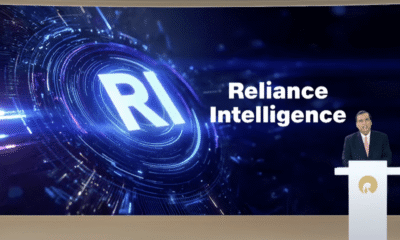Education
10 (and counting…) Google goodies for your classroom

Key points:
Google enthusiasts, unite.
During an ISTELive 25 session, Dr. Wanda Terral, chief of technology for Tennessee’s Lakeland School System, took attendees through a growing list of Google tools, along with some non-Google resources, to boost classroom creativity, productivity, and collaboration.
Here are just 10 of the resources Terral covered–explore the full list for more ideas and resources to increase your Google knowledge.
Education
AI in the classrooms: How Bangladeshi schools are adapting to a new digital era
The recent explosion of Artificial Intelligence (AI) has pervaded numerous industries, going from a futuristic concept to an everyday reality. However, the impact of AI on schooling has been exceptionally staggering.
From helping students complete assignments to reshaping the way teachers think about homework and exams, AI is beginning to redefine education all over the world.
Bangladesh is no different.
Artificial Intelligence isn’t just coming to Bangladeshi classrooms—it’s already here. While its promise of convenience and quick solutions is quite alluring to students, the ever-growing presence of AI in schools has raised difficult questions: is learning actually taking place anymore or is it being replaced by answers generated not from thought, but from machines?
In schools across Bangladesh, AI tools like ChatGPT have quietly revolutionised how students complete their homework, how teachers prepare lessons, and how institutions rethink education altogether.
Is it a blessing or a bane?
Students have quickly adapted to using advanced AI chatbots like ChatGPT, making AI an unavoidable and integral part of academic life. From essays to homework, students are increasingly finding ways to rely on AI not just to work faster, but to sidestep studying altogether.
Many schools and educators have now been forced to accept that resisting AI is no longer an option. Schools must adapt to the new reality or risk becoming redundant.
Yafa Rahman, Vice Principal and Senior Business Studies Teacher of Adroit International School, told The Business Standard, “Talks about integrating AI in the school curriculum is a global concern, and my school has had meetings with Pearson Education on how to do that in the best possible manner as well as train teachers to use AI in a beneficial way while being able to spot unethical AI use. This is an ongoing discussion, and we will see many changes soon.”
Yafa explained that her school also employs AI tools to structure assignments and class content. Rather than banning AI altogether, she believes in channelling students’ fascination with technology into meaningful learning. “Students rely on technology so much that if we incorporate any technology into the learning process, students instantly become more interested,” she said.
Rethinking the curriculum
The convenience of AI comes with a heavy cost. Teachers are reporting a surge in AI-generated assignments. Entire essays, reports, and even personal reflections are being turned in with no human touch. And it’s getting harder to spot the difference.
Educators have responded by rethinking the very structure of education in the country. Oral assessments, in-class essays, and presentations have become increasingly common, as schools seek to test students’ independent thinking rather than their ability to reproduce AI-generated answers.
“For assignments meant to show knowledge and understanding, I’ve returned to using pencil and paper to prevent AI use. For reflective assignments, I encourage students to use AI but remind them to think critically. You do not always have to agree with what AI generated, and key facts and figures must be checked with reliable sources,” said Olivier Gautheron, a Science Teacher at International School Dhaka (ISD) who has earned the “AI Essentials for Educators” certification from Edtech Teachers in the US.
This hybrid approach reflects a wider consensus among educators that AI should not be ignored but incorporated responsibly, encouraging students to refine their critical faculties alongside their digital literacy.
It’s no longer just about stopping AI from being used. It’s about guiding how it’s used.
AI detection
Detecting AI-generated work isn’t straightforward. In universities, plagiarism software and AI detectors are standard. But in schools, teachers often rely on their personal knowledge of each student’s writing style and capability, using their instincts to identify when a student’s writing does not look like their own.
But Gautheron warns against over-reliance on intuition, preferring restraint over wrongful accusations.
“I believe it all comes down to knowing your students and their abilities,” he said. “There’s a high chance of mistakenly identifying student work as AI-generated when it’s not.”
He recalled an incident when he suspected a student of using AI, only to learn that the child had simply used software to improve grammar without altering the ideas. “This is perfectly acceptable, as the purpose of the assignment was for students to generate their own ideas,” he added.
He believes the solution lies not in advanced software but in dialogue. “Although software exists to detect AI, there are other softwares to make them undetectable. I believe that the best way to detect inappropriate use of AI is asking your students directly. If I feel that a student’s work quality is very different from previous tasks, simply asking them to clarify a few ideas of their work is enough.”
For resource-constrained schools, this approach is also pragmatic, since not every institution can afford detection software.
AI for teachers
Just like students, teachers are also increasingly turning to AI for lesson planning and content creation
Emran Taher, Cambridge examiner and senior English instructor at Mastermind School, sees AI as a game-changer.
“It is not just the students who use AI. Teachers and schools are using it too. I can keep my syllabus up-to-date and incorporate more relevant topics and examples instead of just relying on textbooks. This helps grab students’ interest while reducing issues like bunking classes.”
He also uses AI for personalised instruction. By feeding student data—age, class level, strengths, and weaknesses—into AI tools, he receives tailored recommendations that help him address individual needs. “There are no bad students, only bad teachers,” he said.
Striking the right balance
AI’s presence in schools reveals a tension: the same tool that can personalise learning and spark creativity can also be used to bypass real thinking. This balancing act between embracing innovation and preserving the essence of education appears to be the defining challenge of AI use.
However, there is no turning back. AI is already embedded in how schools operate. What matters now is how educators choose to respond. As Bangladeshi schools navigate this shift, teacher training, investment in digital infrastructure, and the development of ethical guidelines will all be crucial.
Some see AI as a threat to academic honesty. Others see it as a catalyst for overdue change in the old, rigid education system. But everyone realises that the role of teachers must evolve to address the new digital landscape.
Education
Education Ministry slammed for AI image of kids starting 1st grade

The Education Ministry was panned across social media over the weekend for posting an AI image to Facebook on Friday of a fictional sextuplets ostensibly starting first grade, ahead of the start of the school year on September 1.
The ministry posted a picture of the six children standing in front of a school with the caption: “Next week we go back to school! In the meantime, meet the only sextuplets in the country who are entering first grade: Oren, Omer, Uri, Nadav, Dvir and Gil Orenstein.”
The post then quoted their fictional mother, Ilanit, as saying: “I invested a lot in raising the children; it’s a great miracle that they were all born healthy. I took a two-year break from work to focus on raising the children and my husband was the sole breadwinner. I am the most excited in the world to see them grow up.”
No such sextuplets exist, and the photo was AI-generated. This fact was not initially made clear by the ministry. The post quickly drew a backlash on social media, with thousands of users slamming the ministry that is supposed to educate children for spreading a lie.
“One of your more embarrassing posts. The education system is collapsing, there are no teachers, no values, and schools are barely managing, and this is what you decide to post? A chauvinistic AI story about imaginary sextuplets with a mom who stays home and a father who supports them,” one person responded on Facebook, garnering 1,700 likes.
“Focus on improving education and not on degrading the conversation online,” she added.
Education Minister Yoav Kisch attends a meeting of the Knesset Education, Culture, and Sports Committee in Jerusalem, May 12, 2025. (Yonatan Sindel/Flash90)
Another commenter said the post was “absurd,” and “typical of the lazy and spineless” Education Minister Yoav Kisch, saying that “these are his values and what he promotes before the start of the school year.”
One commenter said that they asked ChatGPT what it thought of the post, saying that the AI chatbot said it was “highly problematic, especially coming from the Education Ministry.”
“The post undermines public trust [in the ministry], and trust is the foundation of the education system,” ChatGPT added, according to the commenter.
“This is the page that represents the places to which you send your children,” said another poster. “Time to consider homeschooling.”
The ministry later defended the upload, responding in a comment to its original post: “Okay, we admit these sextuplets are not really on the way to first grade, the photo was created with AI.
“We wanted to open the school year with a smile and to remind you that just like in school, on the web we also need to stop, check, and use our critical thinking,” it asserted.
“Wishing everyone a curious, fun school year full of good surprises,” its second post said.

Illustrative photo of students on the first day of school, at the Gabrieli Carmel School in Tel Aviv, on September 1, 2024. (Avshalom Sassoni/Flash90)
The Education Ministry under Kisch has undergone a tumultuous year, which included several teacher strikes, budget issues and a controversial change to public school curriculum, which mandated an hour of bible study each week for all students in first to twelfth grade, as well as additional mandatory classes on Zionism and “Israel’s wars and rebirth.”
Schools will also be required to bring students on tours of Jerusalem and Jewish heritage sites around the country, with an emphasis on sites in the West Bank.
Education
Reimagining Education for Gen Z in the Age of AI

Dean Batson, a communications instructor at Arizona State University (ASU), thought he had designed the perfect midterm exam for his persuasion class. He asked his students to analyze publicly available marketing campaigns using the persuasion principles they had learned in class and turn in a written report. What could go wrong?
Turns out, everything. Almost all 31 students submitted papers on one of two companies: Dove soap and Coca-Cola. A quick investigation revealed those two companies were the go-to responses when ChatGPT received a prompt on the assignment.
“Right off the bat, I knew they were using AI to some extent,” says Batson. “Some of them had opening paragraphs [that were] identical. [I said] to myself… ‘This isn’t going to work. I need to change it.’”
Batson’s experience is not unique. The same phenomenon is unfolding across campuses worldwide. The rise of consumer AI, such as ChatGPT, Claude and Google’s Gemini, has shattered the educational paradigms most of us grew up with, forcing educators to face the uncomfortable truth that traditional education was coasting on life support until the tech companies unceremoniously pulled the plug.
We’re in an age where learning can be outsourced, and academic integrity is often an afterthought. Long term, we’ll start to see professionals, such as doctors, lawyers, accountants and engineers, who lack a fundamental mastery of their specialization.
To combat this slide toward AI dependence, forward-thinking educators have adopted three key transformations: reimagining assessment methods that prioritize uniquely human skills, developing educational frameworks that teach students to collaborate with AI rather than relying on it and creating new ways to measure learning.
Transformation 1: Changing the assessment methods
Traditional methods of assessing knowledge, such as written tests, quizzes and term papers, were easy and efficient to handle many students at once. However, educators observed that these assessment methods are untenable in a world where AI can easily generate these outputs.
Adnan Rasool, Ph.D., director at the Center for Teaching and Learning at the University of Tennessee at Martin, notes that rather than giving students a final paper that accounts for 35% of their final grade, he has implemented regular individual presentations throughout the semester, which account for 25% of a student’s final grade.
The shift forces students to demonstrate a fundamental understanding by thinking on their feet, defending their arguments and responding to cross-examination in real time. Even if students use AI to prepare for oral examinations, AI cannot advocate on their behalf in front of their peers. Rasool also noted that he and many of his colleagues have started using in-class handwritten exams featuring fewer, more comprehensive questions.
Ironically, AI’s disruption pushed educational assessment back to pre-internet era forms of evaluation, proving that sometimes the best way forward is to remember what worked before technology complicated everything.
For some educators, the deep integration of AI into daily life makes bans counterproductive. Instead, some educators are teaching students to collaborate with AI ethically.
MacKenzie Price launched Alpha School based on the premise that children born in the last 20 years are digital natives, and, as such, their education needs to be completely reimagined for an AI-augmented world. Her school relies on AI tutors who teach academic subjects for just two hours each morning, while the remaining hours of the day are spent learning prompt engineering (how to communicate with AI) and developing human skills such as critical thinking, creativity, collaboration and communication.
Price’s school deliberately avoids chatbot interfaces that enable cheating. “We do not use a chatbot feature… because often students use chatbots to cheat,” she notes. “Instead, [we use AI] to provide personalized learning plans that meet every student [at their exact] level.” This system ensures that students see AI as a tool rather than a shortcut. The result is AI-literate students who can partner with AI ethically while mastering uniquely human skills AI cannot replicate.
On the institutional side, Zhuoer (Joy) Chen, who works with educators at AI platform HeyGen, emphasizes that effective AI integration requires significant investment in comprehensive teacher training. She notes that educators who don’t understand AI themselves cannot effectively guide students in using these technologies to achieve better learning outcomes.
Transformation 3: Find new ways of measuring learning
“The best AI work is C-grade,” says Rasool. “One of the things [we’re doing] is instead of burning through our time trying to accuse people of cheating and then spending time trying to prove that… cheating happened or not… we’re encouraging folks to grade AI work as what it is.
“If you think this is not a C and you think this is not the grade you deserve, explain in detail how this is not a C. And 99. 9 % of the time, nobody’s going to show up to tell you how this is not a C.”
Setting a baseline expectation of AI-generated work helps create natural consequences that distinguish genuine learners who excel by incorporating original thinking into their work from students who see their grades plateau at mediocre levels due to their over-reliance on AI.
Price’s Alpha School exemplifies comprehensive new measurements through mastery-based learning where students must reach 90% proficiency before advancing to the next academic milestone, with AI tutors tracking knowledge gaps in real-time. The school validates progress through third-party Measures of Academic Progress (MAP) assessments, which are administered three times a year.
In this new AI-powered environment where limitless knowledge is readily available and the capabilities of large language models expand exponentially, the professional landscape is shifting dramatically. Future doctors and lawyers might no longer require encyclopedic knowledge of their fields, and the new methods for determining professional competence remain an open question.
What is certain is that this challenge requires more than just simple academic reform. The educators pioneering these changes might not know precisely what the future holds. However, they’re ensuring their students develop the adaptability and human-centered skills needed to thrive in whatever comes next.
Photo from Daniel Hoz/Shutterstock.com
-
Tools & Platforms3 weeks ago
Building Trust in Military AI Starts with Opening the Black Box – War on the Rocks
-

 Ethics & Policy1 month ago
Ethics & Policy1 month agoSDAIA Supports Saudi Arabia’s Leadership in Shaping Global AI Ethics, Policy, and Research – وكالة الأنباء السعودية
-

 Events & Conferences3 months ago
Events & Conferences3 months agoJourney to 1000 models: Scaling Instagram’s recommendation system
-

 Jobs & Careers2 months ago
Jobs & Careers2 months agoMumbai-based Perplexity Alternative Has 60k+ Users Without Funding
-

 Funding & Business2 months ago
Funding & Business2 months agoKayak and Expedia race to build AI travel agents that turn social posts into itineraries
-

 Education2 months ago
Education2 months agoVEX Robotics launches AI-powered classroom robotics system
-

 Podcasts & Talks2 months ago
Podcasts & Talks2 months agoHappy 4th of July! 🎆 Made with Veo 3 in Gemini
-

 Business1 day ago
Business1 day agoThe Guardian view on Trump and the Fed: independence is no substitute for accountability | Editorial
-

 Podcasts & Talks2 months ago
Podcasts & Talks2 months agoOpenAI 🤝 @teamganassi
-

 Mergers & Acquisitions2 months ago
Mergers & Acquisitions2 months agoDonald Trump suggests US government review subsidies to Elon Musk’s companies






















